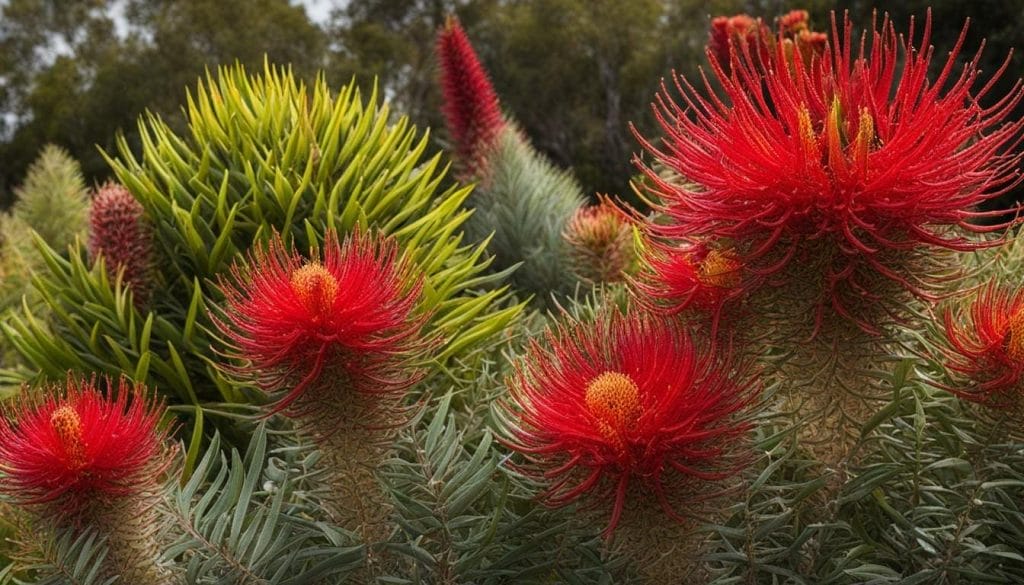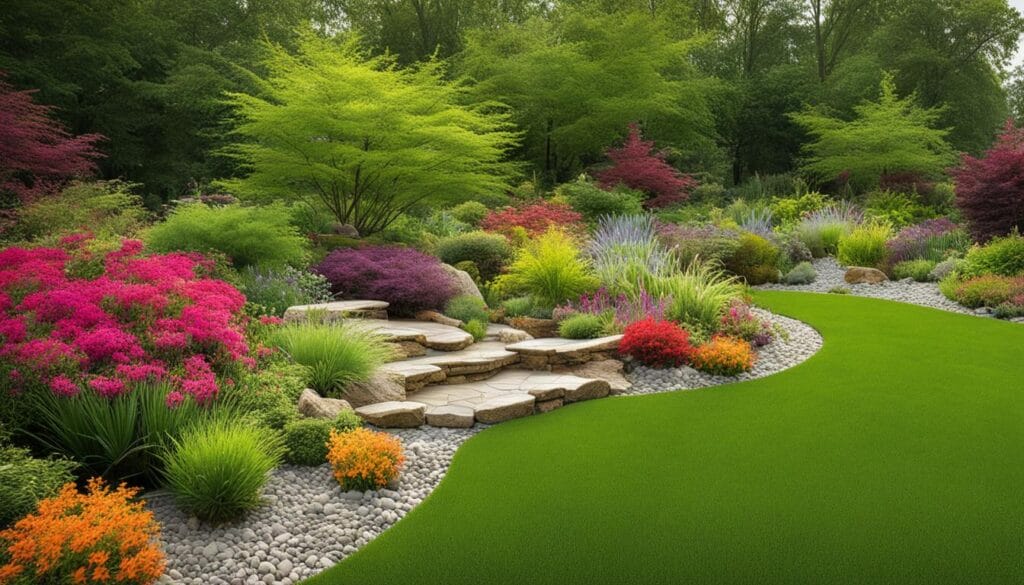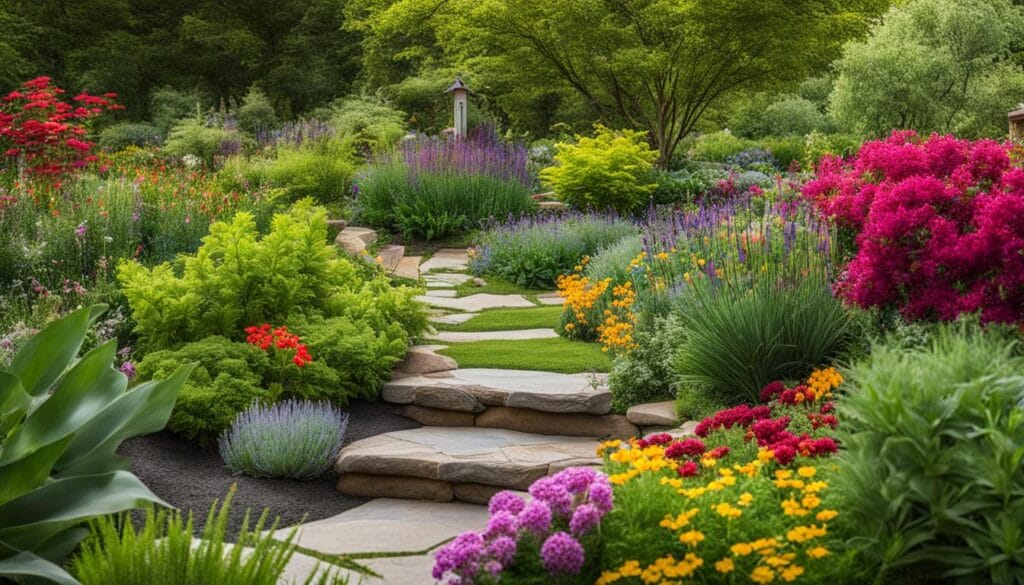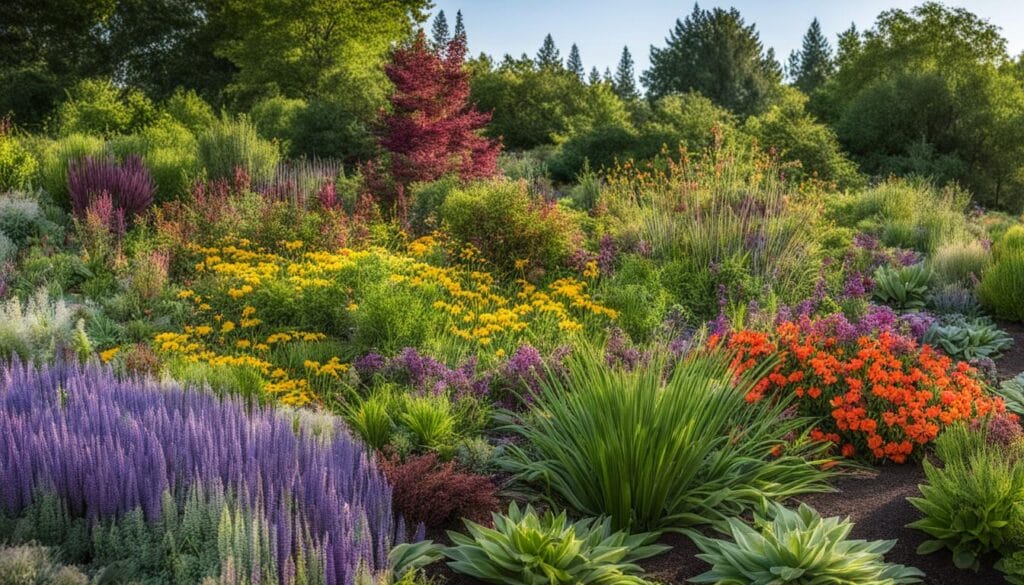Creating a native garden for your Australian home not only celebrates the natural beauty of the country but also supports local ecosystems and reduces maintenance. Native plants are adapted to the local climate and soil, requiring less water, fertilizers, and pesticides. They also attract birds, insects, and other native wildlife, promoting biodiversity. When planning your native garden, consider layering plants, grouping them together for visual impact, and creating paths and focal points. Water-wise gardening techniques like mulching, irrigation, and rainwater harvesting can help conserve water. Regular pruning, weeding, and pest control are necessary for maintenance. With the right design and plant selection, you can create a stunning and sustainable outdoor space that showcases the unique beauty of Australia’s flora.
Key Takeaways:
- Creating a native garden supports local ecosystems and reduces maintenance.
- Native plants require less water, fertilizers, and pesticides.
- Layering plants, grouping them, and creating focal points enhance the visual appeal of your garden.
- Water-wise gardening techniques like mulching, irrigation, and rainwater harvesting help conserve water.
- Regular pruning, weeding, and pest control ensure the longevity and vitality of your native garden.
Australia’s Diverse Native Plant Selection
Australia is renowned for its diverse range of native plants, with approximately 24,000 species. These plants offer an array of colors, textures, and forms that can enhance the beauty of any landscape. When it comes to native landscaping, there are several popular Australian native plants that are commonly used in gardening projects.
One such plant is the Grevillea, a colorful and low-maintenance shrub that attracts birds with its nectar-rich flowers. Grevilleas are available in a variety of sizes and flower forms, making them a versatile choice for different garden styles. Another popular native plant is the Kangaroo Paw, known for its unique paw-shaped flowers in vibrant colors like red, yellow, and orange. These striking flowers add a touch of drama and whimsy to any garden.
Eucalyptus trees, iconic Australian symbols, are also a popular choice in native landscaping. With their attractive bark and foliage, these trees provide a sense of authenticity and connection to the Australian landscape. Banksias are another favorite, with their unique flower spikes that create interest year-round. They come in various sizes, from shrubs to small trees, and are loved by local birds and insects.
To add texture and movement to your garden, consider incorporating native grasses and groundcovers. Grasses like Lomandra, Poa, and native tussock grasses create a lush understorey and require minimal maintenance. Native groundcovers like Myoporum and creeping boobialla can be used to fill gaps, suppress weeds, and add a touch of greenery to the garden floor.
In summary, Australia’s diverse native plant selection offers a multitude of options for creating stunning and sustainable landscapes. Whether you choose grevilleas for their colorful blooms, kangaroo paws for their unique flowers, eucalyptus for their iconic presence, banksias for their year-round interest, or native grasses and groundcovers for their texture, these plants will bring the beauty of Australia’s flora to your home.

Design Principles for Native Gardens
When it comes to designing your native garden, there are important principles to consider that will help you create a visually appealing and harmonious outdoor space. By implementing these design principles, you can make the most of your native plants and create a garden that showcases their natural beauty.
Layering Plants: One key design principle is layering plants, which involves arranging taller trees and shrubs at the back, medium-height plants in the middle, and low-growing groundcovers at the front. This creates depth and a sense of scale in your garden, making it visually appealing and mimicking the natural environment.
Mass Planting: Another effective design technique is mass planting, where you group plants of the same species together. This creates a bold visual impact and emphasizes the beauty of the particular plant. It also provides habitat and resources for wildlife, attracting birds, butterflies, and other beneficial insects to your garden.
Paths and Focal Points: Incorporating paths and focal points in your native garden can help guide the viewer’s eye and create a sense of exploration. Winding paths can lead visitors through the garden, allowing them to discover different sections and enjoy the beauty of each plant. Focal points, such as a striking tree or a beautifully arranged group of plants, can act as visual anchors and add interest to the overall design.
By considering these design principles, you can create a stunning native garden that not only enhances the beauty of your outdoor space but also provides a habitat for local wildlife and promotes biodiversity.

Table: Native Garden Design Principle Examples
| Design Principle | Description |
|---|---|
| Layering Plants | Arranging taller trees and shrubs at the back, medium-height plants in the middle, and low-growing groundcovers at the front to create depth and scale. |
| Mass Planting | Grouping plants of the same species together for a bold visual impact and to provide habitat for wildlife. |
| Paths and Focal Points | Incorporating winding paths and focal points to guide the viewer’s eye and create a sense of exploration and discovery. |
Implementing these design principles will help you create a native garden that is visually appealing, functional, and in harmony with the natural environment. Whether you have a small courtyard or a sprawling backyard, these principles can be applied to create a beautiful and sustainable outdoor space.
Water-Wise Gardening Tips for Native Gardens
Creating a sustainable and water-wise native garden is not only beneficial for the environment but also for the long-term health of your plants. By implementing a few key techniques, you can conserve water and maintain the beauty of your garden.
Mulching
Mulching is an effective way to reduce water evaporation from the soil, suppress weed growth, and regulate soil temperature. Apply a layer of organic mulch, such as wood chips or straw, around your native plants to help retain moisture in the soil. Not only does mulching conserve water, but it also adds organic matter to the soil as it breaks down over time.
Irrigation
When it comes to watering your native garden, drip irrigation is one of the most efficient methods. Drip irrigation delivers water directly to the roots of plants, minimizing evaporation and water waste. Consider installing a drip irrigation system or using soaker hoses to provide water precisely where it’s needed. Additionally, water your plants deeply but infrequently to encourage deep root growth and improve drought tolerance.
Rainwater Harvesting
Take advantage of natural rainfall by harvesting rainwater for your garden. Install rain barrels or tanks to collect and store rainwater. You can then use this water to irrigate your native plants during dry periods. Rainwater is free from chemicals found in tap water and can provide a valuable water source when water restrictions are in place.
| Water-Wise Gardening Tips | Benefits |
|---|---|
| Mulching | Reduces water evaporation, suppresses weeds, regulates soil temperature |
| Irrigation | Minimizes water waste, promotes deep root growth |
| Rainwater Harvesting | Provides a sustainable water source, free from chemicals |
Implementing these water-wise gardening techniques in your native garden will not only conserve water but also create a more sustainable and thriving outdoor space. By taking simple steps to reduce water consumption and maximize the efficiency of watering, you can enjoy a beautiful and environmentally-friendly garden.
Ongoing Maintenance for Native Gardens
Once you have created your stunning native garden, it’s important to ensure its ongoing maintenance to keep it healthy and thriving. While native gardens generally require less upkeep compared to traditional gardens, there are still a few essential tasks you need to perform. These include pruning, weeding, and pest control.
Pruning
Regular pruning is necessary to maintain the shape, health, and bushiness of your native plants. It helps promote new growth, prevents legginess, and ensures that your plants don’t become overgrown. When pruning, remove any dead or diseased branches, as well as any crossed branches that may cause rubbing and damage. Additionally, you can selectively prune to shape your plants and maintain their desired size. Pruning is best done during the plant’s dormant period or after flowering season, depending on the specific plant.
Weeding
Weeds can compete with your native plants for water, nutrients, and sunlight, so it’s important to keep them under control. Regularly inspect your garden for any weed growth and promptly remove them to prevent them from spreading and causing harm. Pull out weeds by hand, ensuring you remove the entire root system to prevent regrowth. Applying a layer of mulch around your plants can also help suppress weed growth and keep your garden looking tidy.
Pest Control
While native plants are generally more resistant to pests and diseases, it’s still important to monitor your garden for any signs of infestation. Aphids, caterpillars, and snails are a few common pests that can damage your plants. Use eco-friendly pest control methods to address any issues, such as introducing beneficial insects like ladybugs or using organic sprays and traps. Regularly inspect your plants for any signs of damage or pests and take appropriate action to prevent further harm.
By regularly performing these maintenance tasks, you can ensure the longevity and vitality of your native garden, allowing it to continue flourishing and providing a beautiful habitat for native wildlife.
Conclusion
Creating a DIY native plant landscape in your home not only enhances the beauty of your outdoor space but also promotes sustainability and supports local ecosystems. By incorporating native plants that are adapted to the local climate and soil conditions, you can reduce the need for water, fertilizers, and pesticides.
Designing your native garden with layering, mass planting, and focal points can create a visually appealing and cohesive look. Implementing water-wise gardening techniques like mulching, irrigation, and rainwater harvesting helps conserve water. Regular maintenance, including pruning, weeding, and pest control, ensures the longevity and vitality of your native garden.
Embrace the beauty of Australia with eco-friendly landscaping using native plants. Let your creativity flow and transform your garden into a stunning, sustainable oasis. With the right design ideas and a dedication to preserving the environment, you can create a space that not only brings joy but also contributes to the well-being of our planet.
FAQ
Why should I create a native garden for my home?
Creating a native garden celebrates the natural beauty of Australia, supports local ecosystems, and reduces maintenance. Native plants are adapted to the local climate and soil, requiring less water, fertilizers, and pesticides. They also attract birds, insects, and other native wildlife, promoting biodiversity.
What are some popular Australian native plants for landscaping projects?
Some popular Australian native plants for landscaping projects include grevilleas, kangaroo paws, eucalyptus, banksias, and native grasses and groundcovers like Lomandra, Poa, and Myoporum.
What design principles should I consider when planning a native garden?
When planning your native garden, consider layering plants, grouping them together for visual impact, and creating paths and focal points. These design principles help create a natural and visually appealing effect in your garden.
How can I conserve water in my native garden?
Mulching with organic material helps conserve moisture, suppress weeds, and regulate soil temperature. Using drip irrigation or water-efficient sprinklers delivers water directly to the plant roots, reducing evaporation. Rainwater harvesting by collecting rainwater in tanks or barrels can also be used for watering your garden.
What ongoing maintenance is required for a native garden?
Regular pruning of plants encourages bushy growth and prevents them from becoming leggy or overgrown. Promptly remove any weeds to prevent them from competing with native plants for water and nutrients. Monitor your garden for pests and diseases and use eco-friendly control methods when needed.



